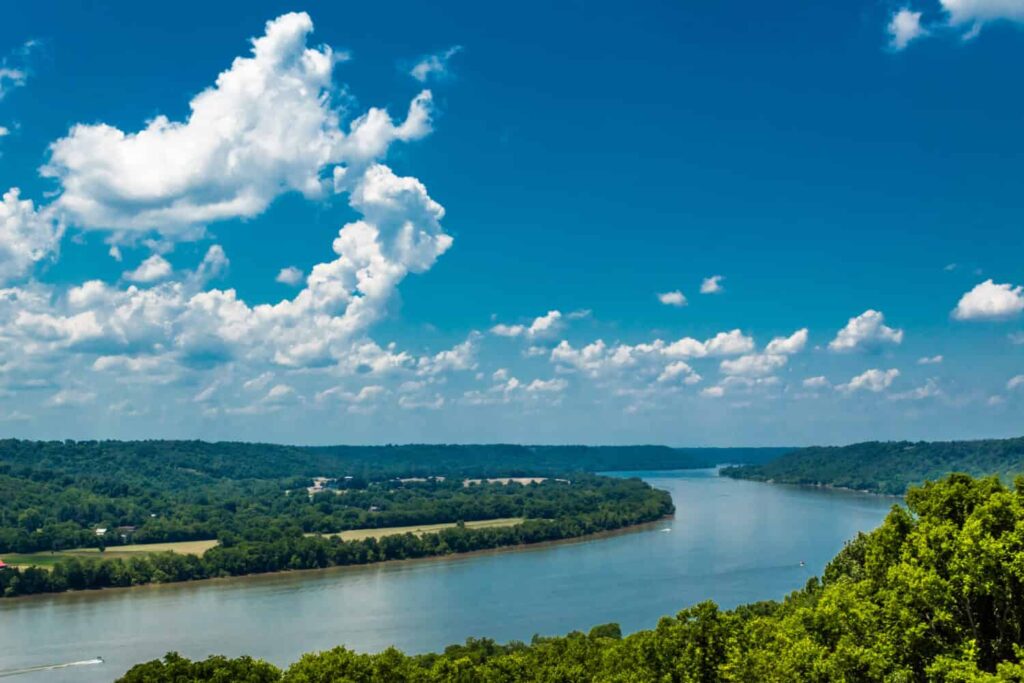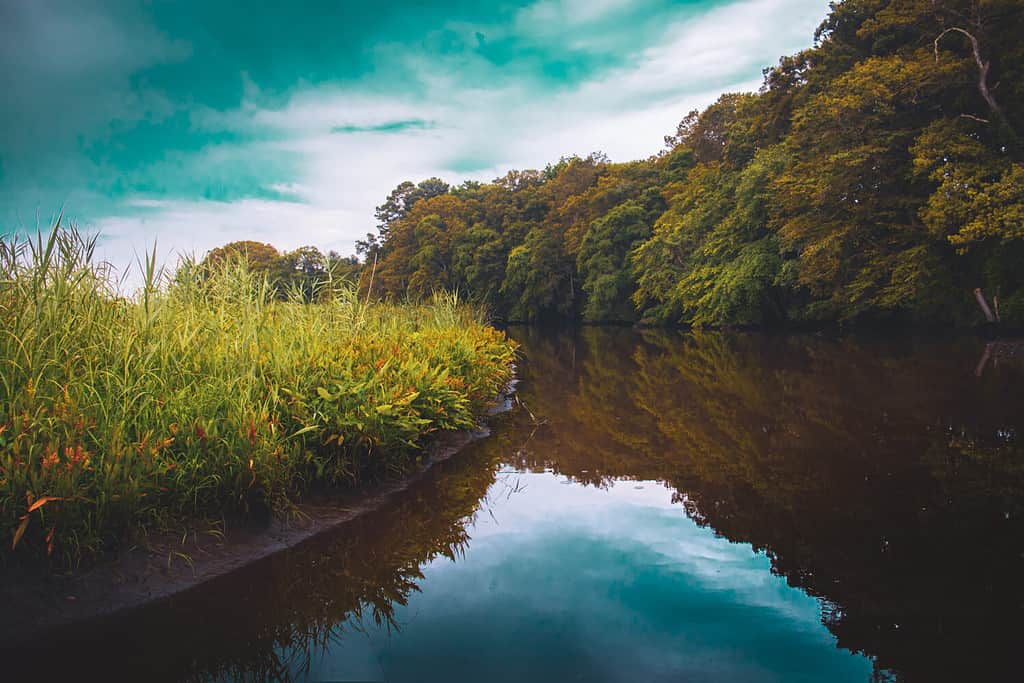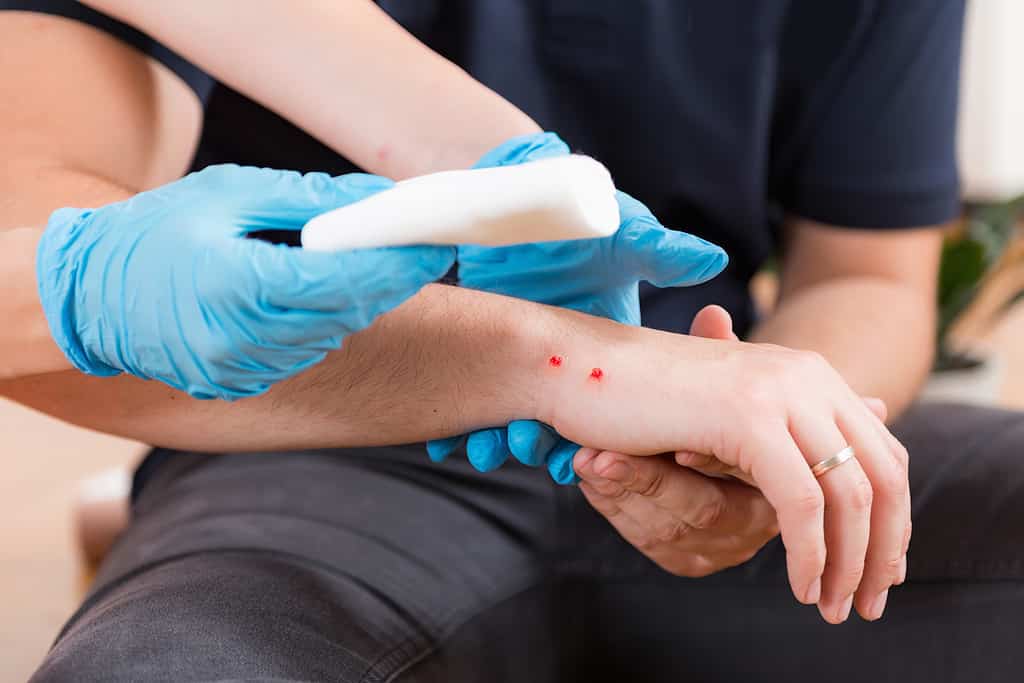Indiana has many rivers, lakes, and streams. When spending a lazy day on an Indiana river, though, the last thing you want to see is a snake’s head popping out of the water. Or even worse — accidentally step on one and get bitten.

Snake encounters in Indiana rivers aren’t uncommon. As such, it’s important to know which bodies of water are the most snake-infested rivers for outdoor enthusiasts and hikers to stay safe while still having fun.
Understanding Indiana’s Snake Species

Brookville Lake is the most snake-infested river in Indiana.
©Anne Kitzman/Shutterstock.com
Did you know Indiana has over 30 types of snakes found within its limits? Of those 32 snakes, at least 10 species are water snakes — or reptiles that live close to or in the water.
There’s only one to be really worried about: the eastern cottonmouth snake, which is the only venomous water snake in Indiana. There are three other venomous snakes in Indiana, but they’re not semi-aquatic. Otherwise, most snakes in Indiana rivers are harmless.
Among the harmless — or at least, nonvenomous — water snake species found in Indiana are:
- The northern water snake (Nerodia sipedon).
- The queen snake (Regina septemvittata).
- The midland water snake (Nerodia sipedon pleuralis).
- The red-bellied water snake (Nerodia erythrogaster).
- The diamondback water snake (Nerodia rhombifer).
Ranking the Top 5 Snake-Infested Rivers in Indiana
Indiana’s snake-infested rivers — while semi-frightening to those who suffer from ophidiophobia, the extreme fear of snakes — do quite a lot to contribute to the state’s thriving biodiversity. Co-existence is crucial to maintain their habitats, so it’s in everyone’s best interest to know which rivers have the highest population of snakes. That way, you can keep yourself and your family safe while watching for any uninvited visitors to your water activities who deserve to enjoy the beauty of the river’s ecosystem too.
Wabash River

The Wabash River is not safe for humans to swim in due to pollution, but snakes make it their home.
©SNEHIT PHOTO/Shutterstock.com
Seven different snakes make the area in and around Wabash River their homes, meaning that the Wabash River is by far the most snake-infested lake in Indiana. Some of the snakes you can see slithering around the mud, shoreline, and waves include:
- The common water snake
- The North American racer.
- The gray rat snake.
- The eastern massasauga.
- The common ribbon snake.
- the common garter snake.
- Kirtland’s snake.
While the pollution has driven some snakes away or tainted their habitats, many of these species remain on the banks — opening even a picnic or walk on the shores of the Wabash to an unexpected snake encounter.
Ohio River

The massive Ohio River runs through parts of southern Indiana.
©Corey B Stevens/Shutterstock.com
Als vying for first place in the most snake-infested rivers in Indiana: the Ohio River that runs through the southern part of Indiana.
The Ohio River spans a massive length of nearly 1000 miles through six states. As such, it’s no wonder that so many snakes call this river home. The banks of the river are a perfect habitat for the very common northern water snake, but queen snakes and some ribbon snake species have been spotted in the Indiana portions of the Ohio River as well.
Tippecanoe River

Tippecanoe River State Park offers canoeing, kayaking, fishing, and hiking — and banks that make great snake habitats.
©Scott J. Kingery/Shutterstock.com
Did you know that Tippecanoe has over half a dozen snake species that live in it? While their populations aren’t as full and widespread as the other rivers on this list, the fact remains that you can see several different varieties of snakes in the river as you hike, fish, or boat through. The most recently recorded snakes seen in the Tippecanoe River, in order, are:
- The queen snake.
- The western rat snake.
- The eastern hog-nose snake.
- The common garter snake.
- The northern water snake.
- The brown snake.
- The western fox snake.
Some of these species, like the western fox snake, haven’t had a recorded encounter in five or more years — but that doesn’t mean they’re not there.
The White River

The White River is the main tributary to the Wabash River.
©Brian C. Gossard/Shutterstock.com
As the Wabash River remains the most snake-infested lake in Indiana, it makes sense that the White River, its main tributary, also has a healthy population of snakes. Similar to the Wabash River, the White River had seen increased pollution. However, this pollution happened in the mid-1990s, and its state is now healthier than it was thirty years ago. As such, snakes like the common garter snake and the northern water snake have grown to call the banks of the White River their home.
Some of the snakes in the White River, or on its banks, will travel downriver for prey and to escape predators. However, most of the time, snakes like to stay close to their nest. Unless threatened, they will make a home and try not to stray far from it.
Grand Kankakee Marsh

The eastern ribbon snakes make their home in what’s left of the Grand Kankakee Marsh.
©Chris Guy Jr/Shutterstock.com
Located in northwestern Indiana, the Grand Kankakee Marsh was one of the largest freshwater wetlands in the United States several decades ago. However, it has recently seen a large reduction due to residential and commercial development. What’s left of its area remains vital for wildlife habitats. The marsh is home to the common eastern ribbon snake (Thamnophis sauritus) frequently found near waterways and grassy marshlands.
Encountering Snakes Responsibly

Only professional, trained wildlife officers should handle snakes encountered in the wild.
©Janelle Lugge/Shutterstock.com
Encountering snakes in the wild demands a responsible and cautious approach to safeguard both human well-being and the preservation of these essential creatures and their habitats. Adopting a proactive and respectful attitude towards snakes is crucial for promoting coexistence and maintaining ecological harmony.
Responsible behavior begins with understanding and respecting snake habitats. With your new education about where large snake populations are in Indiana’s rivers, you can start to understand how, where, and why they choose to live and nest where they do. If you do encounter a snake, it’s important to remember that they:
- Will most likely only show interest in you if they feel imminently threatened.
- Want to protect their young and hunt for food in their normal diets (not humans).
- Are not actively aggressive toward humans, pets, or young children.
- Choose to live their lives solitarily.
Making sure that you watch where you step, educating kids, keeping pets on leashes, and avoiding murky waters where you can’t see the bottom are the best ways to foster a culture of coexistence with snakes and promote their conservation in the wild.
Snakebite First Aid and Myths

Do you know how to administer first aid for a snake bite? Staying calm is the first step.
©Microgen/Shutterstock.com
In the event of a snakebite, prompt action makes all the difference.
- Stay calm: Stay composed and keep as calm as possible to slow your heart rate and reduce the spread of venom.
- Immobilize the affected area: Remain still and keep the limb with the bite at or below heart level.
- Remove tight clothing and jewelry: Remove any constrictive items near the bite site to allow swelling to occur.
- Cleanse the wound: Gently clean the bite with soap and water, but avoid aggressive scrubbing.
- Apply a bandage: Use a sterile dressing to cover the wound, but refrain from tight wrapping.
- Seek immediate medical attention: Regardless of snake bite severity, go to the doctor.
Debunking Common Myths
- Sucking venom out: This old wive’s tale is not recommended. It can lead to further tissue damage and introduce harmful bacteria.
- Tourniquets: Applying a tourniquet can lead to tissue damage and limb loss.
- Cutting the wound: Incising the bite wound to drain venom will not work and simply poses infection risks.
- Applying ice: Ice application does not neutralize the venom and may actually worsen tissue damage.
The Importance of Seeking Immediate Medical Attention
Seeking professional medical attention without delay is crucial for snake bite care. Only healthcare professionals can provide proper evaluation and treatment, identify the snake species, and administer the necessary anti-venom if required. Delaying treatment from a professional with the right tools may lead to severe complications, organ failure, or even death.
Keep Safe, Keep Exploring!
These rivers harbor diverse snake populations, making some of them the most snake-infested rivers in Indiana. Understanding the distribution and ecology of these serpents is crucial for outdoor enthusiasts and conservationists alike. By adopting responsible practices and vigilance during river explorations, we can minimize encounters with snakes, ensuring both human safety and the preservation of these essential reptiles and their habitats. Embracing a harmonious coexistence with Indiana’s snake species allows us to appreciate the beauty and ecological significance of these creatures while contributing to the conservation efforts that safeguard the delicate balance of our natural ecosystems.
The photo featured at the top of this post is © Steven Heim/Shutterstock.com
Discover the "Monster" Snake 5X Bigger than an Anaconda
Every day A-Z Animals sends out some of the most incredible facts in the world from our free newsletter. Want to discover the 10 most beautiful snakes in the world, a "snake island" where you're never more than 3 feet from danger, or a "monster" snake 5X larger than an anaconda? Then sign up right now and you'll start receiving our daily newsletter absolutely free.
Thank you for reading! Have some feedback for us? Contact the AZ Animals editorial team.






